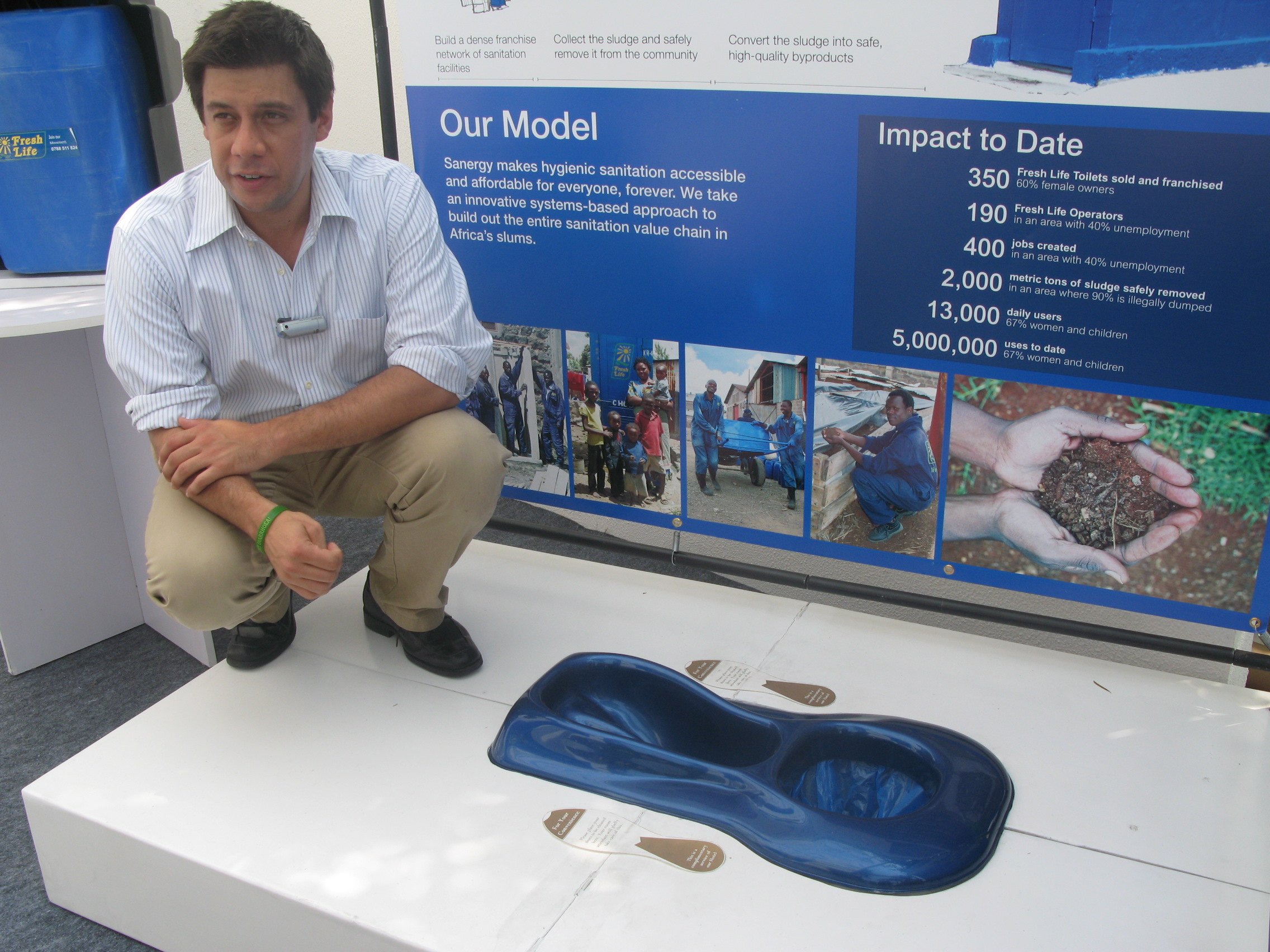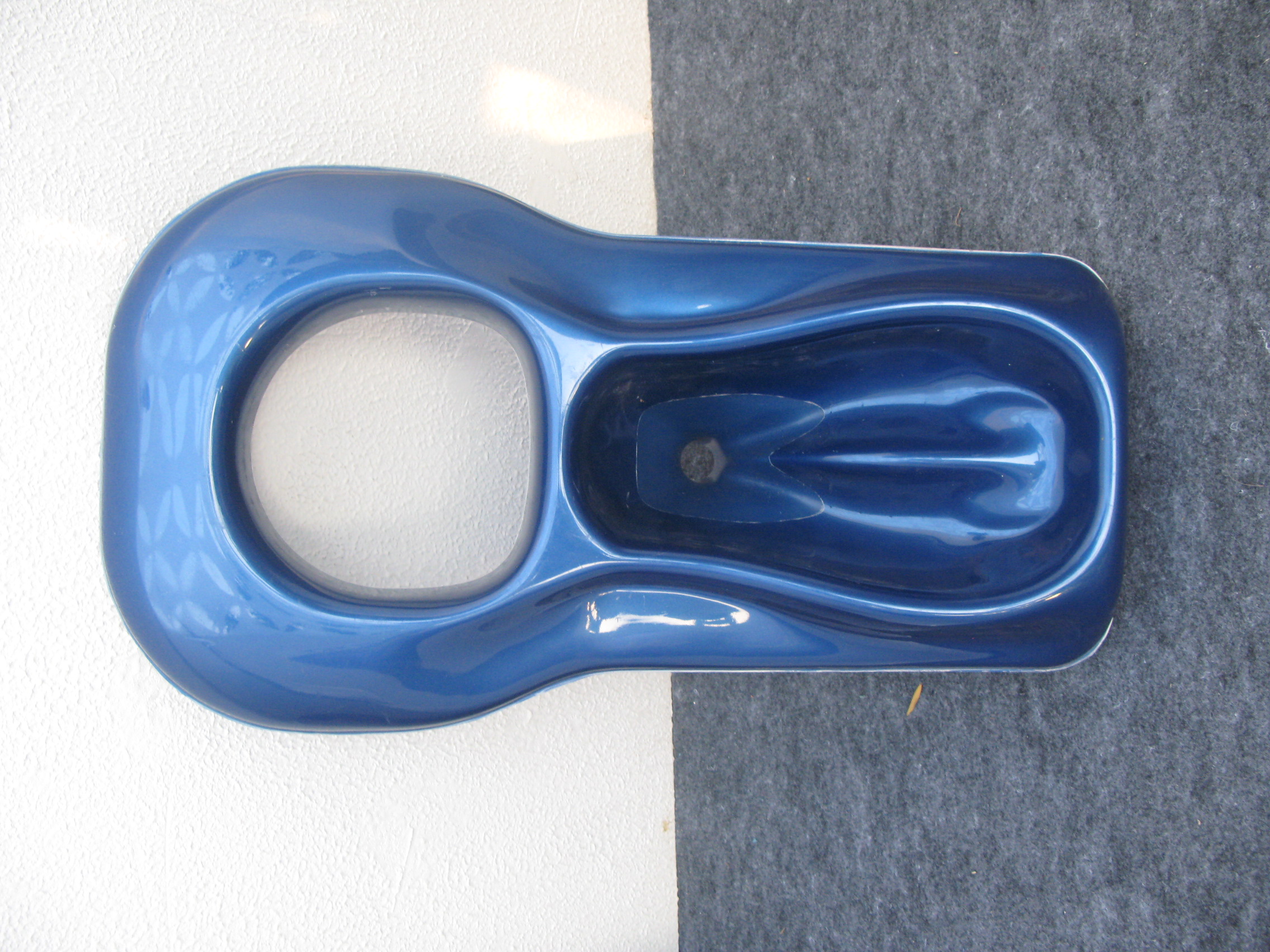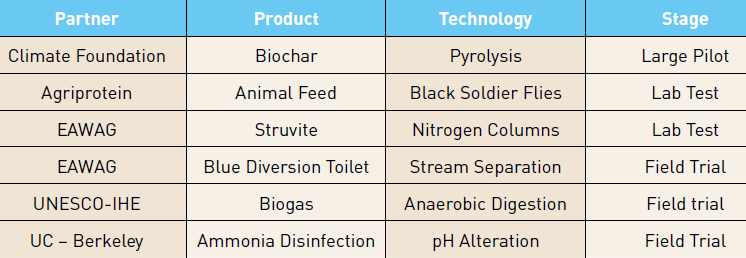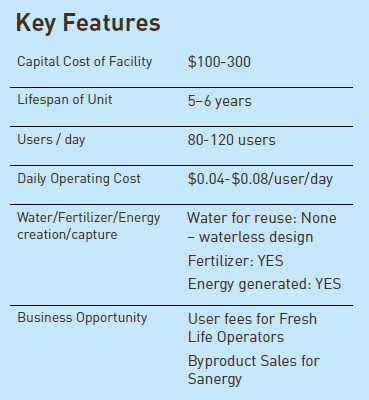- Forum
- categories
- Sanitation systems
- Shared toilets, community toilets, public toilets
- Updates on Sanergy in Kenya (public toilet business with urine diversion and composting)
Updates on Sanergy in Kenya (public toilet business with urine diversion and composting)
72.3k views
- Sanergy
-
- Sanergy
Less- Posts: 10
- Karma: 1
- Likes received: 3
Re: Consumer Insights on Sanitation – Upping the Usage of Fresh Life Toilets (update by Sanergy)
Hi everyone!
We wanted to share our insights on what we are keen to try out in 2015 to influence the uptake of hygienic sanitation in the communities that we work in.
At Sanergy, we provide hygienic, accessible and affordable sanitation in the informal settlements of Nairobi, Kenya. Currently, our network of 620 toilets branded as Fresh Life, are generating over 26,000 uses every single day. We are the largest provider of hygienic sanitation in the areas that we serve.
We always want to raise the bar and serve more community members at each of our toilet locations. Designing and delivering improved sanitation is key, but not enough. We want to take a step further and ensure we provide effective interventions that change human behavior. How do we drastically reduce the number of individuals using unsanitary facilities or practicing open defecation?
In the last six months of 2014, we worked closely with Populist and GRID Impact, research and design firms, to help us understand behaviour change and a deeper grasp of our target audience. The team undertook extensive human-centered design research and identified several key consumer insights that we are keen to explore in our operations.
Fresh Life usage is a very addictive behaviour; once someone has a positive first experience, they will almost definitely become consistent customers. The challenge, then, is inspiring that first usage. We need to explicitly connect the brand to specific, tangible benefits that distinguish it from other options – especially at the moment of choice when someone needs to use the toilet – and motivate people to break their current habits in order to try Fresh Life.
click here
Another insight: the toilet does not speak for itself. That is to say, even though there is widespread brand recognition, non-users have their own perceptions of what it’s like inside or who the target customer is. For example, some think children are our main target because we have a growing presence in schools. While many can recall seeing the blue toilet or ‘Fresh Life’ logo, there is not an easily recalled understanding of what happens inside. Potential users are not armed with a concrete expected experience, and are therefore less likely to find Fresh Life a resonant choice. So how do we change preconceived notions among our potential customers to generate more demand?
A final insight: finally, we need to work with our FLOs to show them that actively recruiting new customers is just as critical as providing high quality service to their existing customers, and that shifting their focus just a bit will help their business grow. We need to come up with better, easier ways for our FLOs to feel comfortable as they promote their services.
We are excited to incorporate some of these insights in our work with the community in 2015. Watch this space for regular updates as we seek to provide hygienic, affordable and accessible sanitation for everyone forever. We would love to hear from you. Let us know what you think!
For more information on Sanergy visit:
Our website: saner.gy/
Like our Facebook page: www.facebook.com/Sanergy
Follow us on Twitter: twitter.com/Sanergy
Please Log in to join the conversation.
You need to login to reply- elizabethtilley
-

- I am interested in how to use technical, social and financial tools to improve sanitation delivery
Less- Posts: 31
- Karma: 8
- Likes received: 22
Re: Fresh Life Toilet in Kenyan slums - improved urine-diverting squatting plate (Sanergy in Nairobi, Kenya)
I should have been more clear in saying that I am NOT trying to offset the costs with any sort of recovered value, but am rather looking into ways in which the costs are feasible, fair, and acceptable to all members of the system.
It wasn't correct of me to say "very few ways" because actually, in my particular context, there are "no ways". More correct would have been to say that I have not found any ways to make the system cost neutral, and very few ways to optimize the payments between the customers and providers, such that we can maximize use and minimize operating costs.
I will definitely keep you posted once my results are ready to share!
Elizabeth
Senior Lecturer
University of Malawi- The Polytechnic
Please Log in to join the conversation.
You need to login to reply- Juergen
-
- I am hydrogeologist and I am working for GIZ since 1992, always in ground water supply (rural and urban drinking water supply and groundwater exploration); about 8 years sector expert WASH with the European Commission's Humanitarian Office.
Less- Posts: 10
- Karma: 1
- Likes received: 5
Re: Fresh Life Toilet in Kenyan slums - improved urine-diverting squatting plate (Sanergy in Nairobi, Kenya)
with regard to the increase in prices for "P", a look onto charts for the last decades and price development does not show an abnormal increase in these prices; rather, speculation spin-offs might play a bit, as with other raw materials.
www.indexmundi.com/de/rohstoffpreise/?wa...hphosphat&monate=240
unveils a bit of reality as opposed to hopes one might have for alternative sources for phosphate. The chart linked-in above displays prices for Moroccan raw material. A geologist's point of view: Morocco is leading exporter for phosphate, but not the only one. Significant resources can be found, e.g., in Spain and some other (north) African countries.
We should remain realistic with expectations, please. Collecting, transporting, processing and using urine in agriculture will, for the foreseeable future, remain dependent on low wages and low income in remote areas in -for the processing purpose- climatically appropriate regions.
Best regards,
Jürgen
Truth is what stands the test of experience. (A. Einstein)
Please Log in to join the conversation.
You need to login to reply- Elisabeth
-
- User is blocked
- Freelance consultant since 2012
Less- Posts: 3372
- Karma: 54
- Likes received: 932
Re: Fresh Life Toilet in Kenyan slums - improved urine-diverting squatting plate (Sanergy in Nairobi, Kenya)
You raised some very pertinent questions in you post on 20 May 2014. From the answer by David I draw my own conclusion that there is no full cost-recovery with the Sanergy model in Kenya yet. It is on the one hand a bit disappointing but on the other hand not surprising, i.e. why should they be the only one worldwide who have found a way to make sanitation provision for the urban poor be able to support itself, solely based on fees, and without any government subsidies (or, in their case, external donor support or some other form of long-term investment)? I think it is simply not possible and need not necessarily be our aim either, as we are talking here about a public good - sanitation, public health (just like education).
You wrote:
I've been doing some modelling for my own research about how a urine collection and transport system can be sustainable and regardless of the scenarios (that I run) I find very few ways in which the income exceeds the costs (especially considering increasing labour and fuel prices).
What are actually these "very few ways"? I asume things like the scenario that fertiliser (phosphorus) prices go up a lot compared to now? That's actually the only one I can think of right now.
(Related thread to this is the VUNA project thread:
forum.susana.org/forum/categories/98-res...mit=12&start=12#7350)
Oh and there was also a post by Kris on Smart Sanitation Subsidies which nobody has picked up on yet:
forum.susana.org/forum/categories/142-up...ation-subsidies#9033
Kind regards,
Elisabeth
Freelance consultant on environmental and climate projects
Please Log in to join the conversation.
You need to login to reply- elizabethtilley
-

- I am interested in how to use technical, social and financial tools to improve sanitation delivery
Less- Posts: 31
- Karma: 8
- Likes received: 22
Re: Fresh Life Toilet in Kenyan slums - improved urine-diverting squatting plate (Sanergy in Nairobi, Kenya)
I can totally understand: I've written to you directly and look forward to learning about whatever results you are able to share at this time.
Best,
Elizabeth
Senior Lecturer
University of Malawi- The Polytechnic
Please Log in to join the conversation.
You need to login to reply- Sanergy
-
- Sanergy
Less- Posts: 10
- Karma: 1
- Likes received: 3
Re: Fresh Life Toilet in Kenyan slums - improved urine-diverting squatting plate (Sanergy in Nairobi, Kenya)
Thanks for your email. We're in good touch with your team at EAWAG and would very much like to continue the conversation offline with you.
Thanks!
David
For more information on Sanergy visit:
Our website: saner.gy/
Like our Facebook page: www.facebook.com/Sanergy
Follow us on Twitter: twitter.com/Sanergy
Please Log in to join the conversation.
You need to login to reply- elizabethtilley
-

- I am interested in how to use technical, social and financial tools to improve sanitation delivery
Less- Posts: 31
- Karma: 8
- Likes received: 22
Re: Fresh Life Toilet in Kenyan slums - improved urine-diverting squatting plate (Sanergy in Nairobi, Kenya)
I've been doing some modelling for my own research about how a urine collection and transport system can be sustainable and regardless of the scenarios (that I run) I find very few ways in which the income exceeds the costs (especially considering increasing labour and fuel prices). (A brief summary is available on the VUNA website: www.vuna.ch)
I would be so grateful to find out more about the breakdown of your (Sanergy) costs (labour, transport, manufacturing) and how you cover those, in terms of franchise fees, nutrient sales, etc. If you're not operating at a cost-recovering point yet, but see that as the goal, how long do you think it will take to get there (measured in terms of toilets or nutrient volume, etc.)?
Many thanks!
Elizabeth
Senior Lecturer
University of Malawi- The Polytechnic
Please Log in to join the conversation.
You need to login to reply- Sanergy
-
- Sanergy
Less- Posts: 10
- Karma: 1
- Likes received: 3
Re: Fresh Life Toilet in Kenyan slums - improved urine-diverting squatting plate (Sanergy in Nairobi, Kenya)
Thanks for the thoughtful piece on our new Fresh Life Toilet design. We appreciate the spotlight as well as the analysis of our work.
One point that we would like to clarify in response to the comment, "One disadvantage is that due to the production process (heat moulding if I remember correctly), the squatting plate now has to consist of two parts (because the urine section is so deep), which means they are joined, and that joint could be a weak spot in terms of urine stone deposits and clearning issues (my personal guess)."
While there are two parts to the squatting plate, the joint which connects the two parts is a shingle joint, which easily allows for liquid to flow over both parts.
However, as we have only in the last 6 weeks put the new design into circulation, it is still too early to tell about the exact wear and tear that the design will take.
Regards,
David Auerbach
For more information on Sanergy visit:
Our website: saner.gy/
Like our Facebook page: www.facebook.com/Sanergy
Follow us on Twitter: twitter.com/Sanergy
Please Log in to join the conversation.
You need to login to reply- Elisabeth
-
- User is blocked
- Freelance consultant since 2012
Less- Posts: 3372
- Karma: 54
- Likes received: 932
Re: Upping the Usage of Fresh Life Toilets (update by Sanergy in Nairobi, Kenya)
Many of you have heard of Sanergy, the impressive social business venture serving an ever-growing number of people in low-income areas in Nairobi, Kenya (also present here on the forum: forum.susana.org/forum/categories/52-mob...ry-loo-user-and-kiva).
Whilst they are not yet a grantee of the Bill & Melinda Gates Foundation, they are an important partner for the BMGF because quite a few of the other grantees are using Sanergy as a full-size testing ground (or "real life lab") for their R&D work. One example is The Climate Foundation with their pyrolysis reactor, see here:
forum.susana.org/forum/categories/98-res...n-usa-and-kenya#8628.
For that reason, Sanergy was also invited to exhibit at the Reinvent the Toilet Fair in Delhi, India, in March 2014.
Here you can find some photos that I took from their exhibit:
www.flickr.com/photos/gtzecosan/sets/72157644699243384/
I had the pleasure of interviewing one of Sanergy's co-founders, David Auerbach. The focus of our conversation was their newly designed urine-diverting squatting plate - which simply looks awesome, see for yourself here in the photos and two videos:


See the interview with David Auerbach here (focussing on the new squat plate that they exhibited):
The second part of the interview, which describes the Sanergy approach and business model, as well as their collaborations with other grantees is available here:
The improved squatting plate has the following benefits:
- Less splashing due to a "fin" which is also used in urinals, and due to a deeper urinal section.
- Urine hole and faeces hole are closer together on a horizontal level, so that less horizontal shifting of the user is needed when they are doing both, one after the other (i.e. urination and defecation).
You can barely see that joint on this photo, almost at the very base of the deep urinal section:

Questions and comments are welcome, I am sure that David or one of his team members will be happy to answer them here on the forum.
Kind regards,
Elisabeth
+++++++++++++++++++++++++
Some further information about Sanergy's work:
R&D work that Sanergy is doing with funding by the Bill & Melinda Gates Foundation:
forum.susana.org/forum/categories/98-res...-scale-sanergy-kenya
Some more information from a recent blog post of Sanergy:
A Fresh New Look for the Fresh Life Toilet
saner.gy/archives/4592
An excerpt of their recent blog post:
Through a partnership with MCAD Technologies and Dassault Systèmes SolidWorks Corporation, a computer-aided design software company, Mike was able to bring the new Fresh Life Toilet to life through 3D modeling, structural simulation of parts, as well as renderings and manufacturing drawings to communicate designs with vendors and field experts.
During initial user testing it was very clear that women were subjected to splash-back when they used the toilet. The new urine-diverting squat plate has a unique form with a deep urine bowl and a splash-eliminating ‘fin’. The squat plate is made from a hard and glossy plastic that is easy to clean and lasts longer than previous squat plate designs.
From the Technical Guides of the Fair
(www.susana.org/lang-en/library?view=ccbktypeitem&type=2&id=2001):
Here you see Sanergy's cooperations with other grantees:
Key information:
Fresh Life Toilet
In African slums, Fresh Life makes hygienic sanitation
accessible and affordable for everyone, forever. We
franchise a dense sanitation network of clean toilets,
collect the waste, and convert it into valuable byproducts.
As of January 2014, 12,000 residents in
Nairobi’s slums are using Fresh Life Toilets every day
with a projected 200,000 in 5 years. Sanergy’s franchising
creates financial opportunity while solving a critical
social and environmental challenge.
Toilet Design
The Fresh Life Toilet is based on a continuous customer
feedback loop and related user research suggests that
a clean, comfortable and friendly sanitation experience
dramatically increases uptake. The Fresh Life Toilet
delivers an enjoyable experience by leveraging features
such as an easily cleaned tile floor and an ergonomic
splash reducing squat plate for women, men, and
children. A durable concrete modular construction,
coupled with powerful community-driven branding –
in partnership with Wash United - makes Fresh Life
preferred sanitation option for all slum residents.
Freelance consultant on environmental and climate projects
Attachments:
-
 sanergy.jpg
(Filesize: 25KB)
sanergy.jpg
(Filesize: 25KB)
-
 sanergy2.jpg
(Filesize: 15KB)
sanergy2.jpg
(Filesize: 15KB)
Please Log in to join the conversation.
You need to login to reply- Sanergy
-
- Sanergy
Less- Posts: 10
- Karma: 1
- Likes received: 3
Sanergy is delighted to formally join the SuSanA Forum! We have contributed as individuals in the past, and now we are excited to have our company’s views be represented in a more professional capacity. We believe that this community offers compelling insights and shares the best of the best practices in hygienic sanitation delivery. We also admire the tireless work of Elisabeth von Muench as she truly advances the conversation on sustainable sanitation. We look forward to working with participants in the forum to improve our work.
This month, we wanted to draw your attention to two interesting pieces of work that are happening here at Sanergy: schools and mystery loo users.
In April 2013, we partnered with Oxfam to provide hygienic sanitation in schools. Oxfam provides financial support, Sanergy identifies schools in the communities we serve and installs Fresh Life Toilets, and Wash United provides ongoing trainings for the students. The results? 15 schools with about 2800 kids having 40 Fresh Life Toilets. Enrolment - a key driver for sustainability - is up 20% at schools. Attendance is up about 20% also - indicating that girls in particular are benefiting from private, dignified hygienic sanitation. You can read more here:
saner.gy/archives/3908 (July 2013)
and
saner.gy/archives/4320 (Nov. 2013)
Our work has attracted the positive attention of the Ministry of Education, which is working with us both to implement our program in government-run schools and to develop relevant curriculum.
The Mystery Loo User program is an important innovation that we developed when we realized that while we love our Fresh Life Operators, we know that they might put their best foot forward when our field officers are coming to visit. Therefore, we set up a program that we’ve now run for about 6 months which ensures that we secretly visit every toilet in the Fresh Life Network at least twice a month. The “mystery loo user“ filled out 16 questions about cleanliness and the quality of service. The results have been really interesting. Most notably, those who are responsible for re-paying a loan to Kiva were far more likely to have extra clean toilets to provide better customer service (Kiva is a micro-lending online platform: www.kiva.org). It’s early days yet, but once again a strong indicator that market forces and a clear business mindset lead to better provision. You can read more about our findings here: saner.gy/archives/4478
We welcome the community’s feedback!
Edith and David
Edith Karimi (Communications) and David Auerbach (Co-Founder) work at Sanergy, a social enterprise that makes hygienic sanitation accessible and affordable in Africa's informal settlements.
For more information on Sanergy visit:
Our website: saner.gy/
Like our Facebook page: www.facebook.com/Sanergy
Follow us on Twitter: twitter.com/Sanergy
Please Log in to join the conversation.
You need to login to reply- Elisabeth
-
- User is blocked
- Freelance consultant since 2012
Less- Posts: 3372
- Karma: 54
- Likes received: 932
Re: Questions about Sanergy
I read about Sanergy's achievements on your twitter account and other places (e.g. here when you won the Sarphati award in November last year: forum.susana.org/forum/categories/95-cal...ack-sim-and-ide#6289).
I have three questions for you today:
(1)
Have you considered for Sanergy to become a SuSanA partner? You would be very welcome.
(2)
I recently saw an article about Sanergy and children in Sanitation Updates (sanitationupdates.wordpress.com/2013/12/...loration-of-sanergy/). The title was:
"Improved Sanitation and Its Impact on Children: An Exploration of Sanergy. Impact Case Study No. 2, 2013."
I copy a part from their executive summary:
Based on the likely outcomes Sanergy has on children across its value chain, we identify opportunities that Sanergy can explore to enhance, deepen, and expand its impacts on children age eight and under and on pregnant women:
• Sanergy should explore more opportunities to work with schools, clinics, women’s groups and workplaces that employ persons from the BoP to increase awareness of the link between improved sanitation and positive long-term impacts on health and finances.
• Sanergy should explore working with ngos and the government to reduce negative impacts that franchisees face during the loan repayment period, as well as encourage the exchange of financial information and best practices among franchisees in quarterly or semi-annual meetings.
• Sanergy can explore piloting pre-paid paper and/or mobile-based payment options for
unaccompanied children to use FLTs.
• Sanergy should explore different payment options for different types of franchisees to attract users from low-income segments.
Beyond these key recommendations, we also offer guidance on conducting impact assessments in a systematic and manageable manner.
The study looks very interesting. Could you please tell the SuSanA forum readers more about this publication, e.g. what does it mean for Sanergy? And how did this study come about? The organization behind it is not one that is well known in the sanitation sector.
And what do you think of the study's recommendations, are you planning to follow any of them?
(3)
I have seen on the twitter account of Oxfam that they have a partnership with Sanergy regarding schools. I asked them where I can find out more about this. The answer from Andy Bastable (Oxfam) was:
Could you tell us more about your partnership with Oxfam, please?Our relationship with Sanergy is relatively simple. We want to get a number of latrines maintained and desludged - currently we are funding Sanergy to install their toilets at a number of schools in Nairobi. In this way the schools have working latrines and it saves the school money.
Oxfam does support the Sanergy private sector model. We would like to see them increase their coverage of latrines and spread the model to other parts of Kenya and possibly other countries. We would like to support this private sector initiative to make toilets in poor areas more sustainable.
In the long term this decreases the role NGO's currently play.
I look forward to your answers to my three little questions. Thanks in advance.
And please feel free to use this forum to update people about your progress (even if you just tell people when one of your newsletters has come out, for example). I think your work is very relevant and interesting because you are running one of the few sanitation projects with urine diversion and resource recovery that is really going to scale now.
Laura Kimani (formerly Laura Kraft) told me recently:
Meanwhile, we have more than 300 toilets and collect daily about 4.5 tons of urine and faeces.
Regards,
Elisabeth
Freelance consultant on environmental and climate projects
Please Log in to join the conversation.
You need to login to reply- former member
-
Less
- Posts: 101
- Likes received: 3
Re: Sanergy question on squat plate
Here my answer to Chris question (which was posed here in connection with the GIZ technology review on UDDTs): forum.susana.org/forum/categories/34-uri...mit=12&start=12#4133):
4. Sanergy's "Fresh Life" UDDT seems very practical and well thought-out. Thank you for adding this to the text. How did they make such a strong but lightweight and hygienic plastic floor?*
This is the photo which Chris is referring to:

Lifted Kentainer slab to reveal the faeces and urine container by Sustainable sanitation , on Flickr
Thanks for the credit Chris. The plastic floor is a ready made squat plate, designed and produced by the Kenyan company Kentainers<www.kentainers.com/>. However since the urine part of this squat plate design is very shallow it can cause urine splashing. We changed our squat plate and are currently using a wooden frame coated with epoxy (self production) where we insert Kentainer's ecoplate as you can see in the picture. The ecoplate design has the advantage that it has a more wide and deep space for urinating and an additional urine guard which minimizes the risk of splashing. Additionally the feces hole is bigger and the edges are raised so that no water from toilet cleaning enters into the feces container.

Sanergy_Fresh_Life by Sustainable sanitation , on Flickr
Best,
Laura
++++++++
Note by moderators: This post was made by a former user with the login name Laura who is no longer a member of this discussion forum.
Please Log in to join the conversation.
You need to login to reply- Forum
- categories
- Sanitation systems
- Shared toilets, community toilets, public toilets
- Updates on Sanergy in Kenya (public toilet business with urine diversion and composting)







